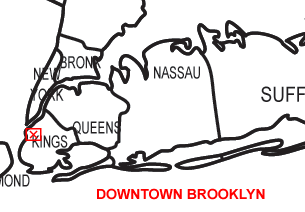 Downtown Brooklyn is located in the Northwestern section of the borough in Brooklyn, New York. It is the third largest central business district in New York City after Midtown Manhattan and Lower Manhattan. Due to its close proximity to lower Manhattan and excellent local and regional mass transit access, Downtown Brooklyn occupies a valuable and unique position in New York City as a competitive, back-office alternative to New Jersey. It was bounded by Tillary Street to the north, Ashland Place to the east, Atlantic Center and Schermerhorn Street to the south, and Court Street to the west; it is a diverse area with a high concentration of major office buildings, regional stores, residential buildings, government offices and a number of major academic and cultural institutions.
Downtown Brooklyn is located in the Northwestern section of the borough in Brooklyn, New York. It is the third largest central business district in New York City after Midtown Manhattan and Lower Manhattan. Due to its close proximity to lower Manhattan and excellent local and regional mass transit access, Downtown Brooklyn occupies a valuable and unique position in New York City as a competitive, back-office alternative to New Jersey. It was bounded by Tillary Street to the north, Ashland Place to the east, Atlantic Center and Schermerhorn Street to the south, and Court Street to the west; it is a diverse area with a high concentration of major office buildings, regional stores, residential buildings, government offices and a number of major academic and cultural institutions.
As of 2010 census, there were 6,468 people residing in the area. The median income for a household in the village is $84,271.
The area’s history was originally inhabited by Lenape Native Indians until the 1600s. At that time the Dutch arrived, gained control of the land, and called it Breuckelen. Until 1814, Downtown Brooklyn and Brooklyn Heights remained lightly populated. The Robert Fulton‘s new steam ferry then began to offer an easy commuting option to and from downtown Manhattan. It made Brooklyn Heights Manhattan’s first community and put Downtown Brooklyn on its way to becoming a commercial center, and the heart of the City of Brooklyn. It was home to many prominent Abolitionists at a time when most New York was pro-slavery. Many churches in the neighborhood fought against legalized slavery in the 1850s and 1860s, some even acting as slave safe-houses as part of the Underground Railroad movement. Walt Whitman was fired from his job as a reporter at the Brooklyn Eagle due to his anti-slavery views when he lived at Willougby and Myrtle.
There has not been a great deal of housing in the commercial and civic center of Downtown Brooklyn. Housing which does exist includes a few apartment buildings on Livingston Street, and seven 15-story buildings that make up the over 1,000 unit Concord Village co-op development on Adams Street, at the borders of both Brooklyn Heights and DUMBO. Since 2003, the area has attracted significant new residential development that include a Brooklyn New School dorm at Boerum Place and State Street, the condo conversion of 110 Livingston Street, a new apartment building at Atlantic and Court Streets, newly constructed luxury residential condominiums at Court and State and on State between Court and Boerum Place.
Brooklyn’s first new hotel in almost 70 years, the New York Marriott Brooklyn, opened here in 1999. Some historic parks like Cadman Plaza Park named for an early televangelist that provides 10 acres of green space in the neighborhood, and were recently renovated by the New York City Parks Department. There was other parks form a long mall from Boro Hall to Brooklyn Bridge. A new park is also planned for the area known as the Willoughby Square Park. The New York City Department planning to become the Downtown Brooklyn a highly-urbanized city in the near future that will include rising the tallest building in the scheme that would remain the bank tower, now re-branded One Hanson Place, with a Borders bookstore in the land-marked lobby. With several towers soon to be rise that will make Downtown Brooklyn a titanium town.




